|
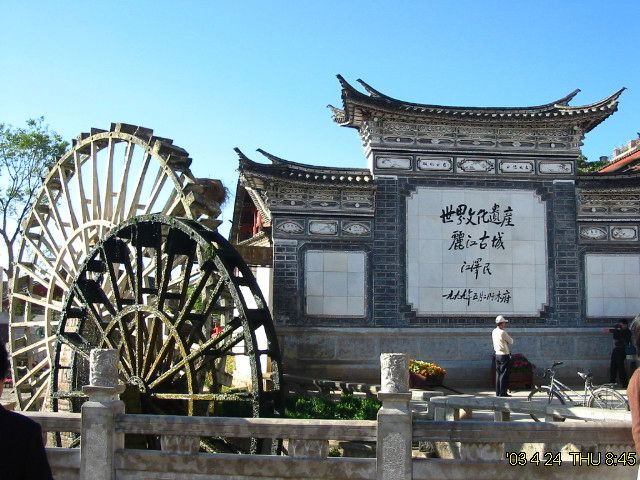 Overview Overview
Lijiang, located in the Northwest of Yunnan Province, is about 580 km away from Kunming. The Ancient Town of Lijiang has a history almost a thousand years. The scenes are unique and unconventional. It is one of the best-preserved historical, cultural cities at the state level in China.
In the Yufeng (Jade Peak) Temple there is an old, giant camellia tree of more than 500 years old, which can put forth thousands of flowers, so that it is called a 'Ten-Thousand-Flower Camellia'. Therefore it is known as 'the First Tree in the World'.
The mystical Dongba hieroglyph is known as 'the only living hieroglyph in the world'. The old Naxi music with noble elegant lingering charm is thought to be the 'living fossil of the Chinese classical music'. Lugu Lake with its deep and transparent water is known as 'the pearl on the plateau'. The Mosuo villages on the Shore of Lugu Lake and the folk customs and the folkways are unique in the world and make tourists open-mouthed. There are still some matriarchal families. The Mosuo people are now still keeping the 'Axia' marriage pattern by which a young man doesn't get married and a girl is not to be married off.
The Ancient Town of Lijiang, also called Dayan Town, was first set up i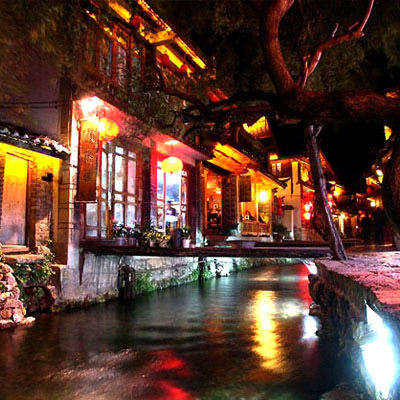 n the Song Dynasty, and has a history of almost a thousand years. The town is famous in China for its old and simple architectural style and the elegant art for the layout of the town. The roads here are parallel to the streams, and the door of each house is facing a stream. Sifang Street is the center of the ancient town. Since ancient times, Sifang Street has been a collecting and distributing center of all kinds of products with travelers and traders going and coming everywhere. n the Song Dynasty, and has a history of almost a thousand years. The town is famous in China for its old and simple architectural style and the elegant art for the layout of the town. The roads here are parallel to the streams, and the door of each house is facing a stream. Sifang Street is the center of the ancient town. Since ancient times, Sifang Street has been a collecting and distributing center of all kinds of products with travelers and traders going and coming everywhere.
The Yulong Snow Mountains are the southernmost modern marine glaciers in the temperate zone of the northern hemisphere. There are all together 13 peaks along the range of the mountains, which stretch for over 35 km from south to north. The summit, Shanzidou, is 5596 meters above sea level. Looked at from a faraway place, the mountains covered with snows look like a silver dragon with the clouds curling up in the middle. Hence the name, the Yulong (Jade Dragon) Snow Mountain.
Attractions
Lijiang old town
Originally called Dayan, Lijiang is a very well preserved old town built by Naxi people with unique cultural background. The old town occupies an area of 3.8 square kilometers. It was first built in Song Dynasty, and has a history of more than 800 years. During Yuan Dynasty, Lijiang has become the political, economic and cultural hub of the region and the staging post along old tea horse road.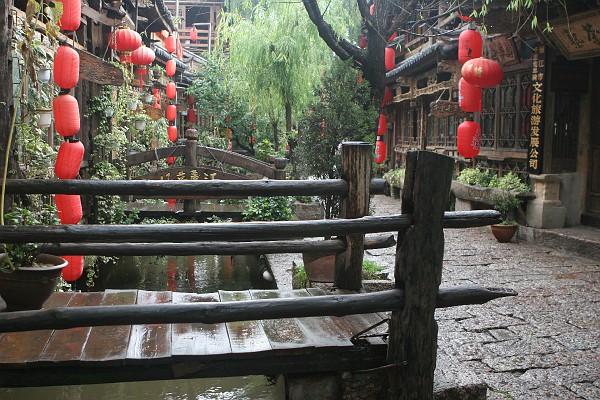
Unlike any other towns in China, Lijiang old city doesn't have a city wall. Legend tells that the governor of the Lijiang has a family name of Mu, which means 'tree' in Chinese language. The family administrated the region for 500 years. If they building a city wall around the town, it may imply putting a frame around 'Mu' character, which constitutes a new character 'Kun', which means 'dilemma' or 'predicament'. The superstitious government would never set him and his family in a hard time, so the city wall has not ever been built around Lijiang old town.
Lijiang old town is prestigious for its unique system of waterways and bridges. Black Dragon Pool (Heilongtan) is the main water source of the town, from which many small rivers flow down along the streets, passing by every family. There are almost 350 varied and inimitable bridges in the little town, some of which were built in the Ming and Qing Dynasties.
Mu's Mansion (Mufu)
Located at the southwest of Lijiang old town, Mu's Mansion was once the residential and working site of the Naxi rulers of Lijiang in the ancient time. It was first built in Ming Dynasty (1368 ? 1644). The family name of the ruler is called 'Mu', hence the name of this mansion. The family governed the Lijiang region during Yuan, Ming and Qing Dynasties, lasting for 22 generations. Their family name 'Mu' was granted by the first Emperor of Ming Dynasty ? Zhu Yuanzhang in 1382.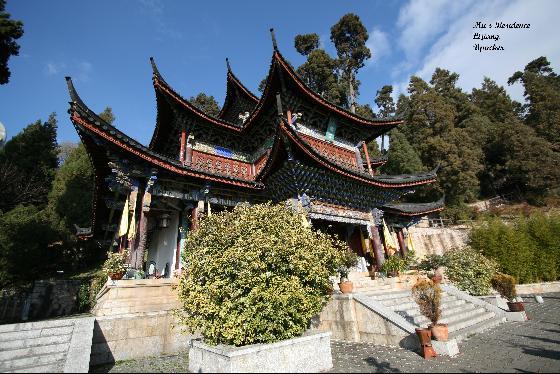
The complex embodies the wisdom and skills of Naxi architects. The famous traveler in Ming Dynasty Xu Xiake once commented: 'It has the palace's magnificence, suitable for the King'. No wonder some people say the mansion is the Forbidden City of Naxi people. Unfortunately most of the buildings were destroyed during the warfare in late Qing Dynasty (1644 ? 1912). The present Mu's Mansion was rebuilt during 1996-1999.
Mu's Mansion covers an area of 46 mu (about 8 acres) and extends a length of 369 meters (about 404 yards). With the Shizi Mountain (Lion Mountain) behind, the complex faces east. The residence consists of two parts: the office area and the living area.
Jade Dragon Snow Mountain
Located 15 km north of Lijiang old town, Jade Dragon Snow Mountain stretches 35 km from north to south with 960-square-kilometers of snow-capped area. Experts say that it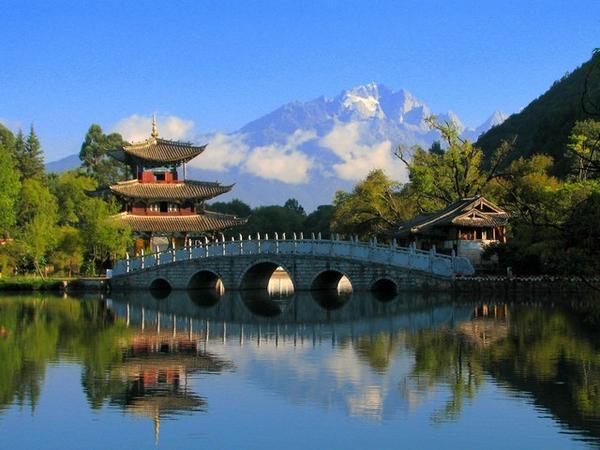 has the southernmost glacier in the North Hemisphere. Of all the 13 peaks on the mountain, Shanzidou is the highest with an altitude of 5,596 meters above sea level. Looking from afar, you can see that the mountain just looks like a huge dragon lying in the cloud. Jade Dragon Snow Mountain is the holy mountain ? 'God of Sanduo' of Naxi people. has the southernmost glacier in the North Hemisphere. Of all the 13 peaks on the mountain, Shanzidou is the highest with an altitude of 5,596 meters above sea level. Looking from afar, you can see that the mountain just looks like a huge dragon lying in the cloud. Jade Dragon Snow Mountain is the holy mountain ? 'God of Sanduo' of Naxi people.
Jade Dragon Snow Mountain now has become a draw for tourists or travelers. The major spots include 3 cable cars to the 3 sites on the mountains (snowline, Yak Meadow and Cloud Fur Meadow), Ganhaizi (meadow, highland pasture), White Water River and nearby Naxi Wenhai Village.
Shuhe Old Town 
Nestled at the foot of Jade Dragon Snow Mountain, 6 km northwest of Lijiang old town, Shuhe was once a staging post at ancient Tea & Horse Road. With an altitude of 2440 meters above sea level, it is a tranquil town with a population of about 3000 people. Along with its sister town Lijiang, it is also part of the UNESCO Heritage site. Shuhe is the earliest settlement of Naxi people in Lijiang when their ancestors first moved to this region.
Shuhe town is just like a small-sized Lijiang with a similar layout, which boasts a Square Street (Sifangjie) and rivers flowing at downtown. It is really a delight to visitors who first come here. Compared with Lijiang, the town is less touristy and polished with more original characters.
In history, with the rise of Tea & Horse Road, Shuhe town was a major producer of leatherworking in the region.
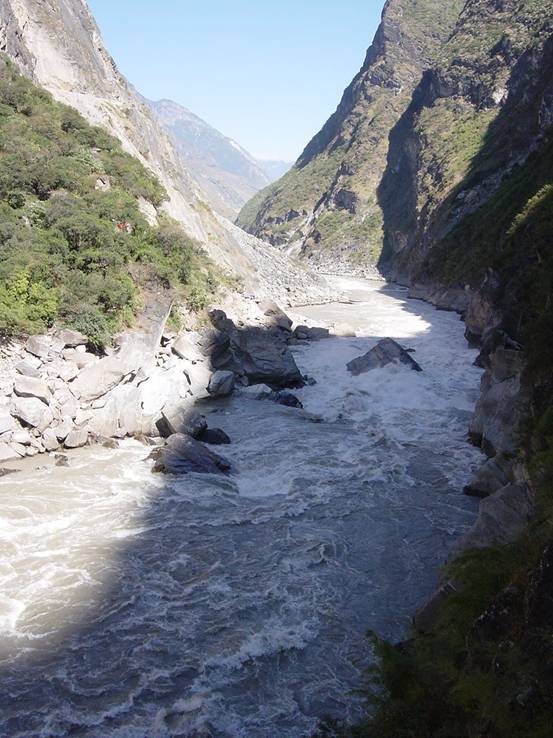
Tiger Leaping Gorge (Hutiaoxia)
60 km north of Lijiang old town, Tiger Leaping Gorge is a canyon on the upper reach of the Yangtze River, which part is usually called Jinsha River (Golden Sand River). The gorge is located where the river passes between 5,596-meter-high Jade Dragon Snow Mountain and 5,396-meter-high Haba Snow Mountain in a series of rapids under lofty 2000-metee-deep cliffs. Legend says a tiger could jump across the river at the narrowest point (still 25 meters wide), hence the name.
 Lugu Lake Lugu Lake
2690 meters above sea level, Lugu Lake is a gem located at the mountainous area on the border of Sichuan and Yunnan Province. About 240 km northeast of Lijiang, the lake occupies an area of 50 square kilometers with the average water depth of 45 meters. The lake is sparklingly clear, dotted with 5 islands.
Mosuo people live around the lake, which is a small tribe that is considered a sub clan of Naxi people. They are a matriarchal society and seek to maintain the heritage. Taking a large dugout canoe at the smooth lake rowed by a Mosuo girl is very interesting; she will sing a beautiful folk song to the visitors. The lake area is an absolutely an undisturbed from the bustling outside world.
Dining
Lijiang's local specialties are Baba and Jidou Liangfen. Lijiang Baba is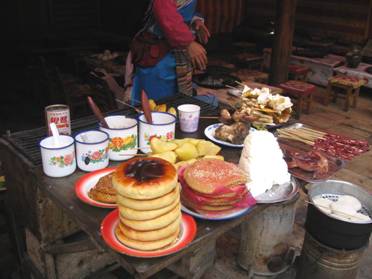 a thick flatbreads of wheat, served plain or stuffed with meats, vegetable or sweets. Jidou Liangfen is made of beans grown locally and jelly-like. Though with a weird color, it is one of the most popular foods in Lijiang. Tibetan tea, also known as yak butter tea, is widely served in local restaurants. Heavy herbal soup is another delicacy in the area. Like rest part of Yunnan Province, local dishes are featured with hot spiciness. a thick flatbreads of wheat, served plain or stuffed with meats, vegetable or sweets. Jidou Liangfen is made of beans grown locally and jelly-like. Though with a weird color, it is one of the most popular foods in Lijiang. Tibetan tea, also known as yak butter tea, is widely served in local restaurants. Heavy herbal soup is another delicacy in the area. Like rest part of Yunnan Province, local dishes are featured with hot spiciness.
Some restaurants and cafes provide varieties of western food like pizza, hamburgers, sandwich, spaghetti and others. Popular restaurants include Sakura Café, Mama Fu's Restaurant and Old Town Beef Restaurant.
Shopping
In recent years, with its tourist industrial development, Quick Guide offers various kinds of souvenirs to its visitors. Of particular interest are the exotic handcrafts of the Naxi Group.
Local crafts are colorful and unique. Naxi bracelets and necklaces carved with ancient Dongba hieroglyphs seem popular with tourists. Individually designed T-shirts can be created as locals have the capacity to paint on the Dongba hieroglyphics required. Knitted shawls of the Naxi Group have been popular with female travelers for quite some time. All of these things can be easily found in Quick Guide Old Town at a reasonable price.
Other popular souvenirs include the Bunong and Jixiang Bells and Naxi murals. Bunong Bells draw their inspiration from the bells of the horse caravans that once traveled the Tea-horse Ancient Road. Local handcrafts show the romantic horse caravan culture from years ago. The Jixiang Bell, known as the lucky bell, was a sacrificial utensil of the Naxi Group. The Naxi Mural is praised as the gem of Naxi culture reflecting the kind and intelligent aspect of Naxi people. A piece of Naxi mural, with its elaborate pictures and use of pastel colors provides a wonderful decorationt to family and friends.
Two kinds of mild wine produced in Lijiang are favored by some travelers. U Wine's history can be traced back to the Ming Dynasty (1368-1644). Sulima Wine is specially brewed by Mosuo people who live in Ninglang Yi Autonomous County, northeast of Lijiang City. It is important to check your country's Customs restrictions prior to purchase if you intend taking these wines out of the country.
The most famous shopping center of Lijiang is Square Street, the most bustling area of the city. It provides another interesting experience to your trip. A large number of souvenir shops are located here, selling various kinds of decorations and handicrafts. Some shops are owned locals while others are opened by gold diggers from other places in China.
|